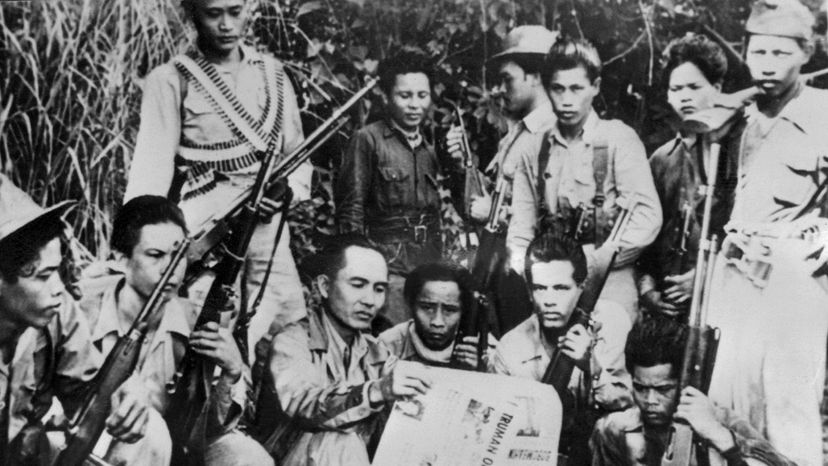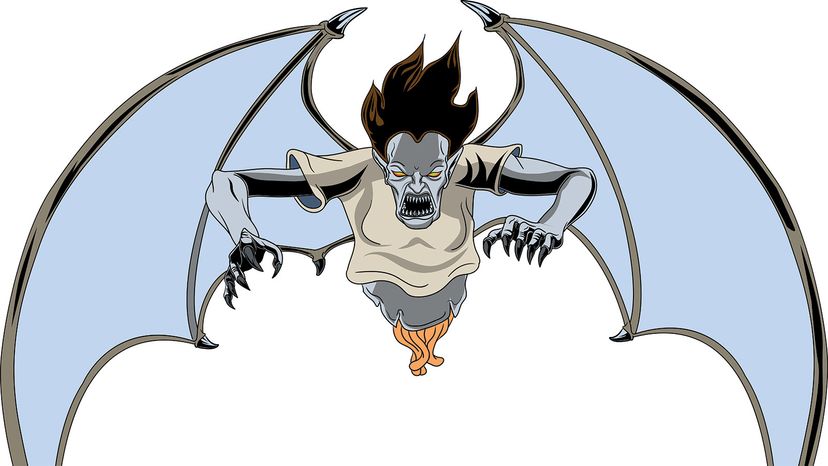
There are more than 7,000 islands that make up the Philippines, and the former Spanish colony is home to 175 different languages and a wide array of cultural practices. But if there's one indigenous belief that survived centuries of Spanish rule and continues to haunt Philippine nightmares, it's the terrifying bogey man known as the aswang.
The aswang doesn't have an exact match in the Western pantheon of monsters. Some people call it a vampire, but it feeds on more than just blood (organs, unborn children, phlegm) and it can take on alternate forms like a giant pig, a nasty dog or even a man-sized vulture. Whatever shape it takes, the aswang is widely believed to be the source of sudden illness, mysterious deaths and other misfortunes in the Philippines.
AD BLOCKER DETECTED!
We have detected that you are using an ad blocker which is preventing the player to display. To support this website and our publishers we ask you to please turn your ad blocker off so that you may enjoy this great content.
Believe it or not, back in the Cold War craziness of the 1950s, a CIA operative in the Philippines took advantage of aswang superstitions to scare off communist rebels. And how he did it — puncturing a victim's neck with two vampire-like holes, hanging them from a tree and draining them of their blood — might have been even scarier than the aswang legend itself.
Contents
Aswang, the 'Bringer of Awful Things'

Jordan Clark is a filmmaker and researcher who has devoted years to studying aswang lore in the Philippines. He runs The Aswang Project website and directed a documentary web series called "Creatures of Philippine Mythology."
"The aswang is a very old cultural belief that means something different to each region of the Philippines," says Clark in an email. "The belief that the aswang was the main bringer of awful things was likely very prevalent before Spanish arrival."
In 1589, a Spanish friar named Juan de Plasencia documented the indigenous beliefs in "devils" and other demons in a book called, "Customs of the Tagalogs" (Tagalog is one of the main languages spoken in the Philippines).
"The distinctions made among the priests of the devil were as follows," wrote de Plasencia. "...the eighth they called OSUANG, which is equivalent to 'sorcerer;' they say that they have seen him fly, and that he murdered men and ate their flesh."
The vampiric, humanoid form of the aswang lurks on rooftops at night and can lower its long, proboscis-like tongue through a "lick hole" in the ceiling. The aswang is believed to target particularly vulnerable victims like pregnant women and children, either by sucking out their insides with its prehensile tongue or infecting them with a deadly disease.
Clark says that belief in the aswang is strongest in regions of the Philippines that were heavily influenced by Hinduism before the Spanish arrival, and that other regions have their own animist explanations for illness, miscarriage or death.
"It was a way to explain such occurrences and enlist the help of a shaman to use natural remedies and ritual to heal the person and vanquish the unwanted spirit," says Clark, who says that belief in the aswang can still "wreak havoc" in rural pockets of the Philippines, even leading to the occasional "witch hunt" for the alleged perpetrator.
Enter Ed Lansdale, Ad Man Turned CIA Agent
Before the outbreak of World War II, Edward Geary Lansdale was a San Francisco-based advertising whiz with clients like Levi Strauss, Wells Fargo and Nestlé. When America entered the war, Lansdale joined the Army like hundreds of thousands of patriotic GIs. The Army recognized Lansdale's talents and recruited him to the Office of Strategic Services (OSS), a precursor to the CIA.
Lansdale capitalized on his advertising experience to become a pioneer of "psychological operations," the targeted use of propaganda, media and marketing strategies to win support for the allies and demonize the enemy. When WWII was over, the U.S. government needed Lansdale's special skills to defeat a new enemy: the Soviet Union and its communist operatives in Southeast Asia.
In 1950, Lansdale arrived in the Philippines as (officially) an Air Force officer and adviser to the Philippine President Ramon Magsaysay. What Lansdale didn't print on his business card was that he was really working for the CIA.
Lansdale was assigned to the Philippines because Magsaysay and his U.S.-backed regime were fighting a protracted war against communist rebels known as the Huks (pronounced "hooks"). During WWII, the Huks were a heroic Philippine army that fought the Japanese (their full name in Tagalog was Hukbo ng Bayan Laban sa Hapon or "the People's Anti-Japanese Army"). But after the war, the Huks and their leader, Luis Taruc, broke with the government over the controversial Philippine Trade Act of 1946, which handed the American government "equal rights" to the Philippines' natural resources.
The Huks had legitimate complaints, since the "free" elections in the Philippines were rigged by U.S. operatives and the CIA also controlled the Philippine "free press." But to hear Lansdale explain it in his memoir, "In the Midst of Wars: An American's Mission to Southeast Asia," he was sent to the Philippines to protect the democratically elected government from dangerous communist rebels.
"My orders were plain," wrote Lansdale. "The United States government wanted me to give all help feasible to the Philippine government in stopping the attempt by the Communist-led Huks to overthrow that government by force. My help was to consist mainly of advice where needed and desired. It was up to me to figure out how best to do this.
"Conventional military men think of combat psywar almost exclusively in terms of leaflets or broadcasts appealing to the enemy to surrender," he continued. "Early on, I realized that psywar had a wider potential than that."
The 'Eye of God' and Other 'Psywar' Tactics
Lansdale and his CIA team got busy doing a military version of "market research," according to William Blum, author of "Killing Hope: U.S. Military and CIA Interventions Since World War II."
"Lansdale's team conducted a careful study of the superstitions of the Filipino peasants living in Huk areas," wrote Blum, "Their lore, taboos, and myths were examined for clues to the appropriate appeals that could wean them from supporting the insurgents."
According to Blum, one of Lansdale's tactics was to fly over Huk-controlled areas in a light aircraft and broadcast "mysterious curses" in Tagalog on any villagers who offered help to the Huk soldiers. "The tactic reportedly succeeded in starving some Huk units into surrender."
In his memoir, Lansdale brags about an improvised bit of homemade voodoo he called "the eye of God." It was based on a WWII psywar tactic of learning the names of individual German officers and announcing on the battlefield over loudspeakers that they would be the next to die if they didn't surrender. Lansdale's twist was to paint a cryptic symbol he called the "eye of God" outside the homes of suspected Huk sympathizers.
"The mysterious presence of these malevolent eyes the next morning had a sharply sobering effect," wrote Lansdale.
Blood-sucking CIA Agents
But Lansdale was clearly proud of his most brazen and bloody psychological warfare operation in the Philippines. According to Lansdale, a Huk squadron had set up camp on a hill outside of a village. The village leaders claimed that the Huks threatened to kill any village "bigwigs" who didn't cooperate.
Lansdale sent in a CIA-trained "combat psywar squad" with clear instructions. First, the Philippine psyops agents were to plant stories among the villagers that an aswang was haunting the hill where the Huks were camped. Then after a few days — enough time for the rumors to infiltrate the Huk encampment — it was time to strike.
Here's how Lansdale described the operation in his own words:
"[T]he psywar squad set up an ambush along the trail used by the Huks. When a Huk patrol came along the trail, the ambushers silently snatched the last man of the patrol, their move unseen in the dark night. They punctured his neck with two holes, vampire-fashion, held the body up by the heels, drained it of blood, and put the corpse back on the trail. When the Huks returned to look for the missing man and found their bloodless comrade, every member of the patrol believed that the asuang had got him and that one of them would be next if they remained on that hill. When daylight came, the whole Huk squadron moved out of the vicinity."
To be clear, a CIA-trained squad of Philippine soldiers kidnapped Huk fighters and killed them vampire-style, leaving their bloodless corpses behind. Clark of The Aswang Project thinks that's pretty messed-up.
"To me, this is a brutal and horrific scene with or without the aswang lore," says Clark. "It's not even clear if the Huks believed it was an aswang killing the people or if they were horrified at the desecration of the deceased by the CIA-advised troops."
In his research, Clark found that people in that region of the Philippines believed in a creature called the manananggal, a self-segmenting type of aswang that fed on the fetuses of pregnant women, not a Dracula-style blood-sucker.
"There was no 'vampire-like' aswang lore in the region, so I am skeptical that this psywar tactic even worked," says Clark, "other than the terrifying visual of seeing your friend strung up like that."
Clark also points out that the "aswang scare tactic" was apparently only used once to dislodge a Huk squadron of between 100 and 300 soldiers. It didn't win the entire war. In the end, though, the Huk insurgency was worn down by years of fighting the U.S.-backed regime. Luis Taroc, the Huk leader, surrendered in 1954.